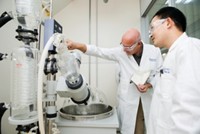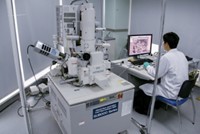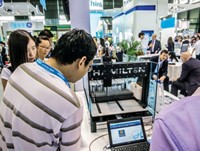Advertisement
Grab your lab coat. Let's get started
Welcome!
Welcome!
Create an account below to get 6 C&EN articles per month, receive newsletters and more - all free.
It seems this is your first time logging in online. Please enter the following information to continue.
As an ACS member you automatically get access to this site. All we need is few more details to create your reading experience.
Not you? Sign in with a different account.
Not you? Sign in with a different account.
ERROR 1
ERROR 1
ERROR 2
ERROR 2
ERROR 2
ERROR 2
ERROR 2
Password and Confirm password must match.
If you have an ACS member number, please enter it here so we can link this account to your membership. (optional)
ERROR 2
ACS values your privacy. By submitting your information, you are gaining access to C&EN and subscribing to our weekly newsletter. We use the information you provide to make your reading experience better, and we will never sell your data to third party members.
Policy
Lab Automation Group Boosts China Activities
As Chinese labs get more sophisticated, the need for support grows
by Jean-François Tremblay
July 23, 2012
| A version of this story appeared in
Volume 90, Issue 30
The U.S.-based Society for Laboratory Automation & Screening held its second annual Asian conference and trade show in Shanghai last month. The event continued a ramp-up up of SLAS operations in China as the instrumentation used in labs there becomes increasingly sophisticated.
SLAS is a nonprofit organization that supports both users and suppliers of automated lab equipment. The group is beefing up its presence in China as its corporate members expand their sales in the country and as its individual members relocate there. SLAS opened a small office in Shanghai last year that is now staffed with five people.
China offers very few lab automation events or opportunities for users to educate themselves, said Gregory F. Dummer, SLAS’s chief executive officer. To his knowledge—and confirmed by exhibitors at the trade show—the SLAS meeting is currently the main automated instrumentation event on China’s calendar. And interest in it is growing. Whereas the first Shanghai conference attracted 290 people, attendance surged to 491 this year, he reports.
The conference featured academic researchers from U.S. universities and scientific managers from multinational drug companies. “We are combining a high-end scientific conference with a trade show, and this is attractive to all the audiences we serve,” Dummer said. He attributes the higher attendance in part to shifting much of the planning and organization of the conference to staffers in the Shanghai office.
Some smaller instrument makers are caught in a chicken-and-egg dilemma when it comes to trying to expand in China, observed Steve Hamilton, SLAS’s director of education. They do not yet offer technical support in the country because they have few customers there, but building sales in China is difficult for instrument company managers who cannot convince potential customers that they will have support.
The trade show provided an opportunity for equipment vendors and local scientists to learn more about each other. “Everybody is educating everybody to an extent,” Hamilton said.
In the past, lab heads in China may have preferred to hire lots of poorly paid technicians instead of investing in fancy foreign-made equipment such as high-throughput screeners. But it’s becoming unrealistic to continue using humans instead of machines, said Ira Hoffman, managing director of HighRes Biosolutions, a manufacturer of automated lab systems exhibiting at the fair. “Automation removes human error, and the results are more consistent,” he said.
Similarly, humans are simply incapable of executing certain lab tasks, said Daniel Sipes, director of advanced automation technologies at the Genomics Institute of the Novartis Research Foundation. The Torrey Pines, Calif., institute is a research center that also develops and sells equipment for automating drug discovery.
“You can sometimes substitute humans for robots, but not for extremely small samples like our systems handle,” Sipes said. The Genomics Institute has so far sold only one system in China, he said, adding that more opportunities will present themselves over the coming years.
Sophisticated machines are useless to people who don’t know what they’re for. SLAS plans to provide training to local lab scientists, who are generally younger in China than they are in the U.S.
In the area of drug research and development, Chinese scientists are getting closer to developing new drugs. But many Chinese scientists still lack an understanding of the whole R&D process and how sophisticated instrumentation can advance it, Hamilton added. “SLAS can teach drug discovery and development strategies and tactical know-how of things like preparing assays,” he said.
Ultimately, SLAS’s expanding presence in China is justified by the expansion of its membership base in the country. “If our members felt Antarctica was the place,” Hamilton said, “we would go there too.”





Join the conversation
Contact the reporter
Submit a Letter to the Editor for publication
Engage with us on Twitter